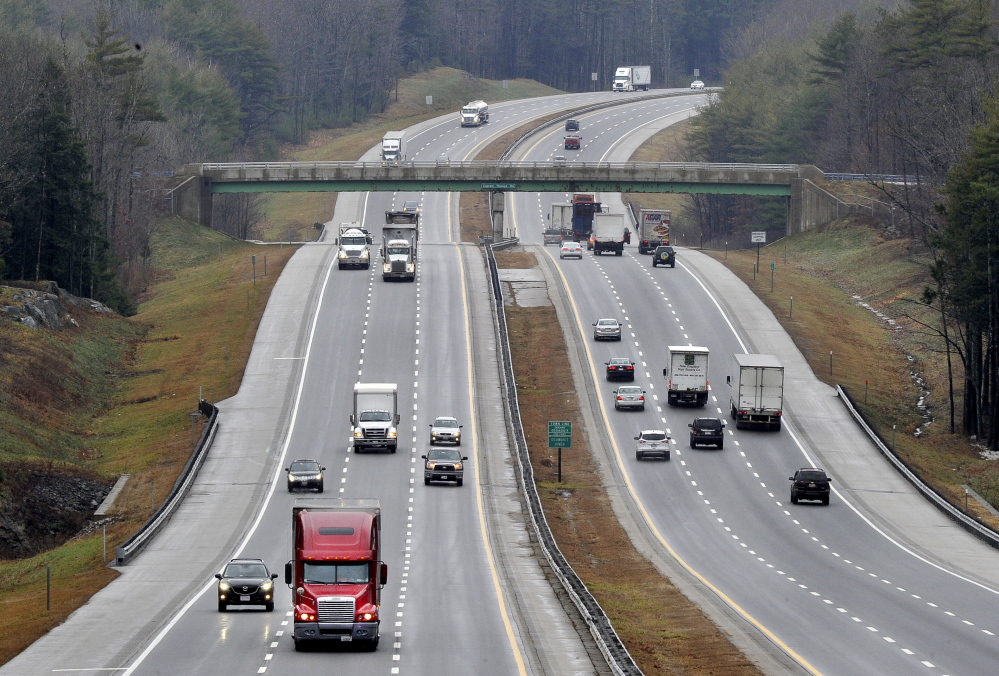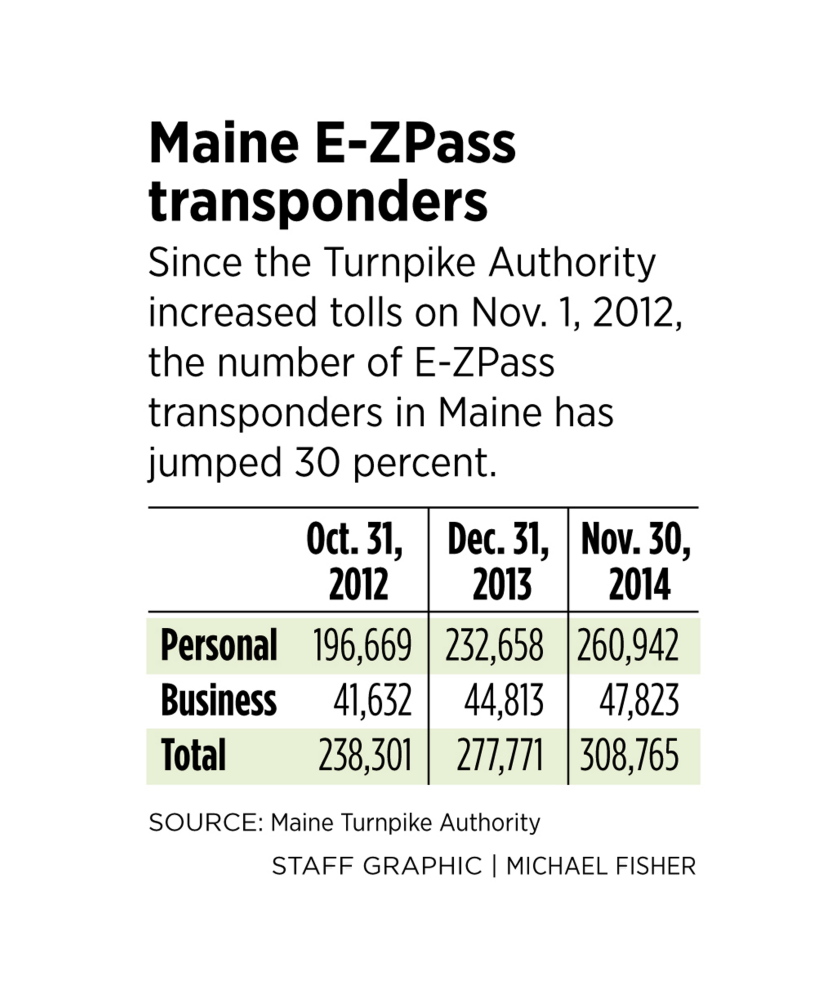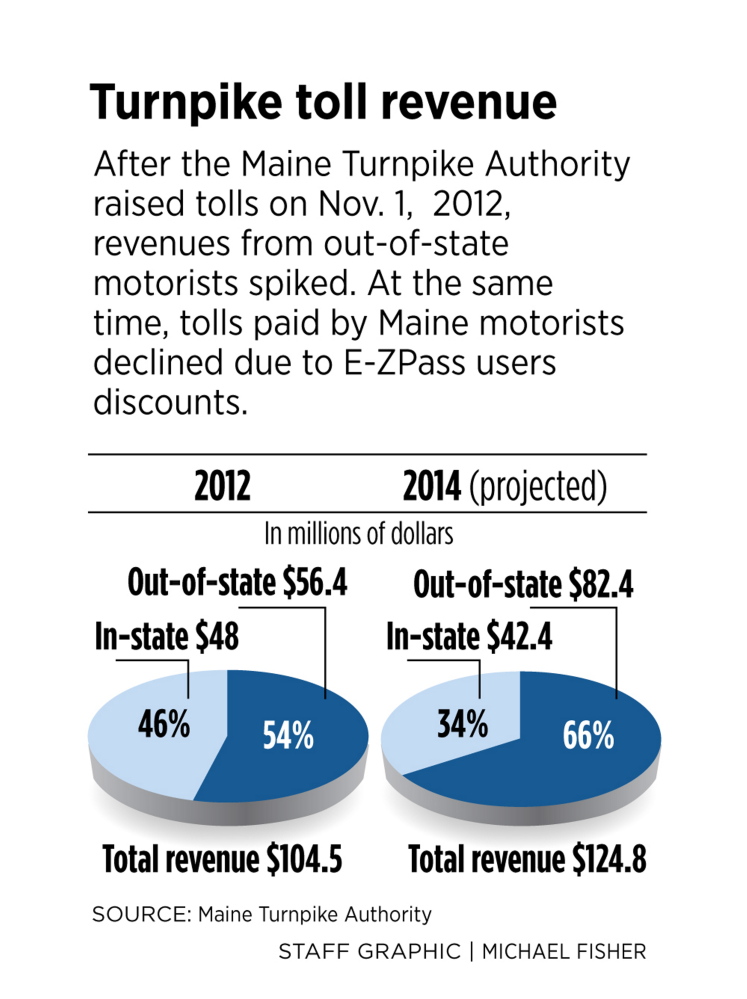Out-of-staters are paying two-thirds of the revenue collected on the Maine Turnpike, a big jump from two years ago when tolls were increased sharply.
In 2012, the turnpike collected $105 million, 54 percent of which was paid by out-of-state motorists. This year the turnpike is on track to collect $125 million, with 66 percent of it paid by out-of-staters.
The shifting burden for covering the highway’s costs is a result of the Maine Turnpike Authority’s push over the past two years to convince more Mainers to pay their tolls using E-ZPass transponders, which allow for discounted rates. The authority this year has been selling about 2,800 transponders a month.
Because an estimated 65 percent of motorists who pay cash are from out-of-state, and because motorists with E-ZPass transponders from other states also pay the cash rate, the authority estimates that out-of-state motorists this year will pay $82.4 million of the total projected revenues.
The agency’s conclusion that most people who pay cash are from out-of-state is based on a year-round survey last year in which photographs of vehicle license plates were taken at all tollbooths on the 109-mile highway, which stretches from York to Augusta.
The 20 percent toll hike enacted two years ago generated an additional $20 million in revenues in 2012. Maine motorists this year are on track to pay $42.4 million in tolls, $5.6 million less than two years ago.
“It was all on the back of out-of-staters,” Douglas Davidson, the authority’s chief financial officer, said of the revenue increase.
Peter Mills, the agency’s executive director, said officials have tried to boost revenues for the authority without adding a financial burden to Maine residents. To do that, he encourages the use of E-ZPass, which allows the agency to provide Maine motorists with discounts and also lowers the cost of collecting tolls.
“This is how we mitigate the toll increase,” said Mills, who plans to discuss the turnpike authority’s finances next Wednesday during his annual meeting with Gov. Paul LePage and on Thursday with the authority’s board of directors.
Motorists who have a Maine-issued E-ZPass pay 7.7 cents per turnpike mile, with a minimum fee of 50 cents and a maximum fee of the cash rate. A driver traveling the nearly 12 miles between York and Wells, for example, would pay 90 cents rather than the $3 cash toll. If motorists make more than 40 one-way trips in a month anywhere on the turnpike, they get a rebate worth half their total toll costs that month. In that instance, the cost of each trip between York and Wells would drop to 45 cents.
The transponders, which the authority previously sold for $25, now cost $10. To heighten awareness of the program, the authority has aired occasional radio ads during commuting hours for the past two years.
Whatever the reason, the popularity of the E-ZPass has grown. Between Oct. 31, 2012, and Nov. 30, 2014, the number of Maine-issued E-ZPass transponders increased 30 percent, from 238,000 to 309,000. Motorists using Maine-issued E-ZPass transponders saved $8 million in 2014 through November.
In addition to saving motorists money, the E-ZPass saves them time by diverting them to through-lanes at toll plazas. That, in turn, has saved the authority money by reducing the number of cash lanes it has to staff and maintain, Mills said. Toll collectors have not been replaced as they retire, and in 2013 the agency laid off between 10 and 12 toll collection supervisors.
In 2003, the agency spent 27 percent of its gross revenue on toll collection and administration costs. By 2013 those costs had dropped by half, Mills said.
Through November, the authority took in $114 million in toll revenues, an increase of 1.2 percent over the same period in 2013. As for volume, there were nearly 70 million E-ZPass and cash transactions, up more than 3 percent over the same period.
Send questions/comments to the editors.





Comments are no longer available on this story